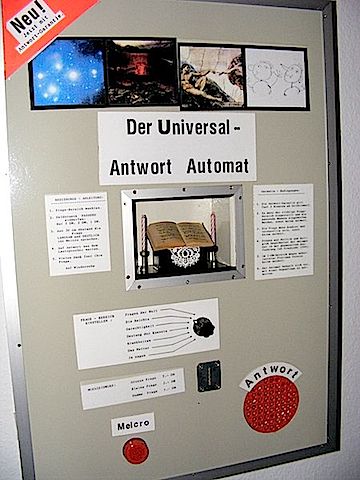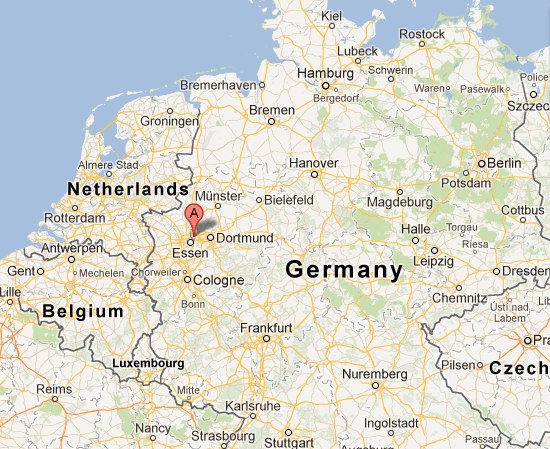
In 1992 and 1993, Ingrid stayed with us while she attended a year of high school here in Maryland. After she returned to her family in Germany, she and her parents often invited us to visit. At long last we took them up on their invitation. This was Gail's first ever trip to Europe.
Gail prepared for the trip by purchasing a Pimsleur German language course and practicing with the disks. Al had trouble keeping German separate from the Spanish he has been trying to learn during the past two years. Fortunately, Ingrid's family speaks excellent English and many other people we met spoke good English.

|
Ingrid lives in Gelsenkirchen, in the Ruhr district of western Germany. |
|
Gail and I flew on SAS from Dulles on May 23. The uncomfortable seats and
mad dash through the Copenhagen airport to catch our connecting flight were
worth it when we found
Ingrid waiting at the Dusseldorf airport to welcome us and to take us to Gelsenkirchen.
To help our recovery from jet lag, Ingrid and her parents took us on a bike ride to Zollverein, a world heritage mining and industrial site in the nearby city of Essen. The Ruhr is a mining region like Iron County, where Al grew up, so the mine head frames were familiar. One surprise to us was that it did not get dark until 10 p.m. It turns out that Germany is a lot farther north than Maryland, closer to the latitude of Newfoundland so the summer days are longer than in Maryland. |
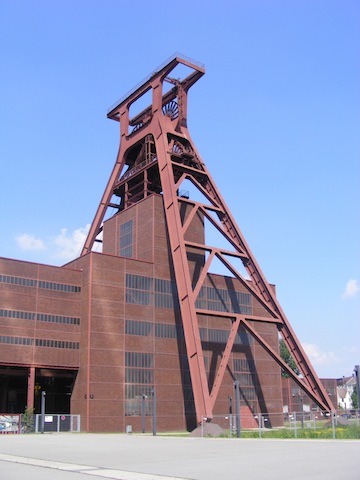
|
The following day we visited the town of Xanten, where the Roman empire had established a city east of the Rhine River. Xanten is the location of an Archaeological Park showing reconstructions of some of the Roman buildings as well as a large, covered excavation of the foundations of the the Roman bath. Xanten is also a living city with a cathedral dedicated to St. Victor, a plaza surrounded by modern shops and cafes, and even one cafe that grinds its own flour with an ancient windmill,
|
A partially reconstructed Roman temple |
A historic windmill sitting on top of a cafe and grinding the flour for the bread served there |
|---|---|
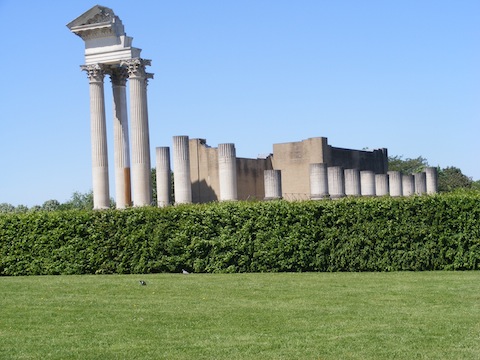
|
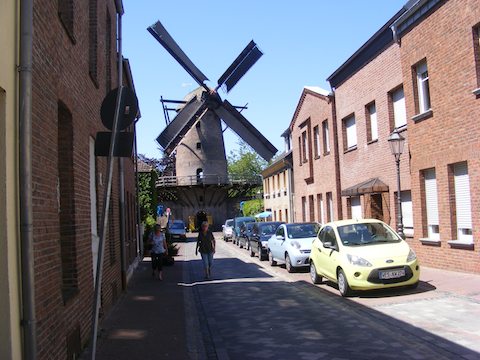
|
|
A portion of the town square with St. Victor's Cathedral Behind |
Carved religious panel inside St. Victor's Cathedral |
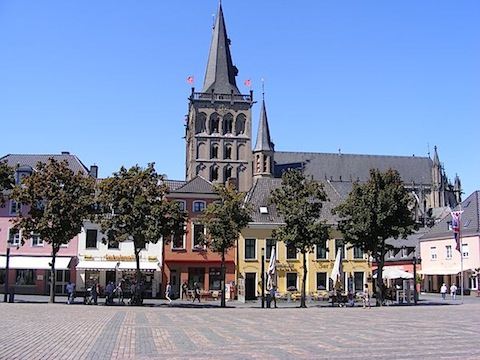
|
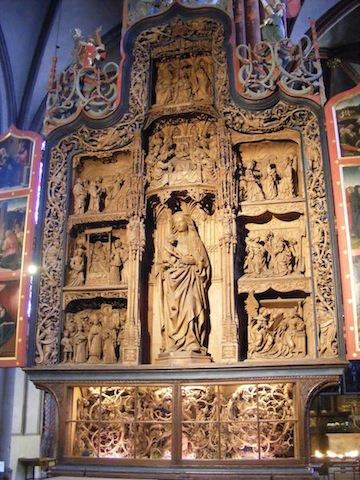
|
After a day exploring the historical side of Germany, we explored the natural side on a trail in the Sauerland. It was a tough path to walk in places, especially with the baby stroller, but we wound up at a tavern where we were refreshed. On this hike we saw our only snake, a small nondescript specimen.
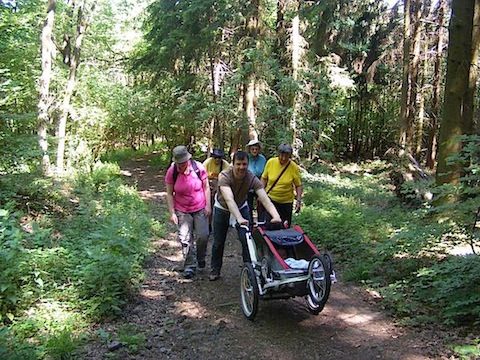
|
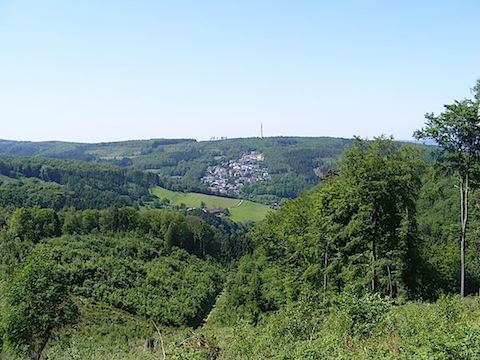
|
Next Ingrid and Holger, her husband, took us to the big city of Köln, where we saw the cathedral - the Dom - and the Kolumba museum. We got our exercise early. While Ingrid watched her one-year old son at ground level, Gail, Holger and I climbed 97 meters (319 feet) in a small circular stairway within the walls of the south tower to its observation platform. It was a long climb and we had to stop several times to catch our breath.
The inside of the Dom was grand and awesome. The building seemed to go on for a very long distance, both horizontally and vertically. The stained-glass windows shone brilliantly. At the end of the cathedral was a shrine of the three Magi, in which they believe they have the bones of the three Wise Men.
The Kolumba museum had an exhibit titled thinking - An exhibition of ways to experience the world, that intermingled contemporary art with religious art going back to medieval times. I especially enjoyed some drawings on the theme of space-time by Victoria Bell. Furthermore, the ground floor of the museum contained the archeological dig of the foundations of the church of Saint Kolumba, which had been established on this location in the second or third century, and then modified and enlarged until the 16th century.
We had dinner, and some beer, in a brewery, the Früh Cölner Hofbräu, and then followed it up with ice cream sundaes at a ice cream shop. (There always was an ice cream shop conveniently nearby!)
|
The side entrance to the Dom Photo thanks to Gail |
The awesome interior of the Köln Dom |
|---|---|
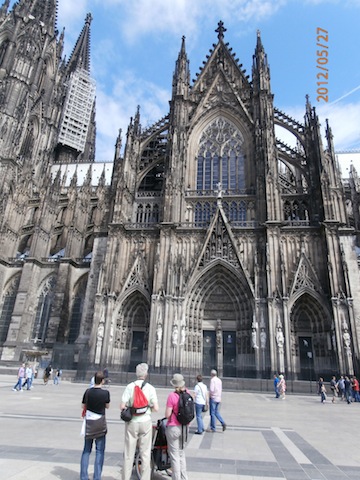
|
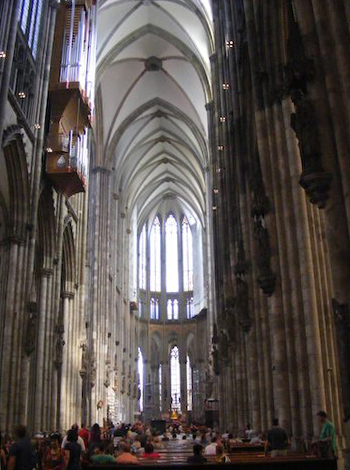
|
|
One of the Dom's stained-glass windows showing the descent from the cross and, below, the four Evangelists |
Shrine of the Magi in the Dom |
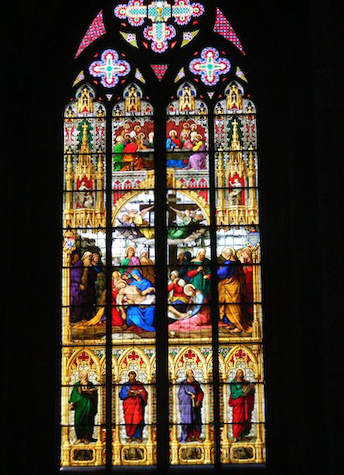
|
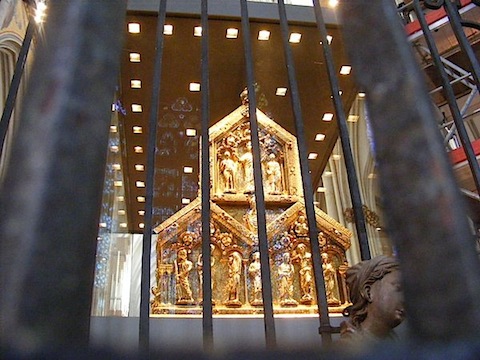
|
|
Paintings in the Kolumba Museum |
Gail and Felix, Ingrid's one-year old son |
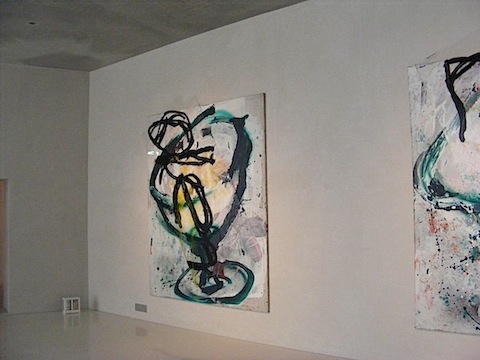
|
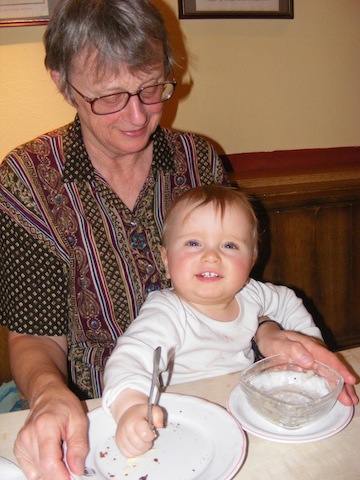
|
Many, if not all, of the slag heaps that resulted from the Ruhr's industrial past are now crowned with art installations. We visited two: the Heaven's Stairway in Gelsenkirchen and the Turtle and Tiger walking roller coaster in Duisberg.
|
Heaven's Stairway with Gail, Ingrid and Katrin |
Turtle and Tiger |
|---|---|
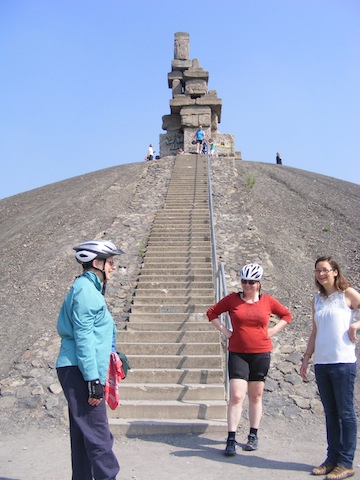
|
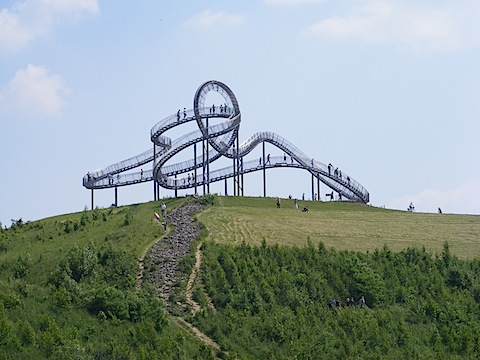
|
One afternoon we took a short trip to Münster. Many people there use bicycles for their transportation so it is necessary to be careful when walking to avoid being run over. This city has a university, a 1760s era palace and a 13th century cathedral of St. Paul, but its main claim to fame is its being the location of the 1648 signing of the Peace of Westphalia, that ended the Thirty Years War and recognized the independence of the Netherlands and of Switzerland. We visited the Rathaus (city hall) where the treaty was signed. Although much of the building, and much of the rest of the city, was destroyed during WW2, the paneling, paintings and other furnishings had been removed from the building before it was bombed. We felt close to the historical events in the repaired and restored council chambers.
|
Facade of the Münster Rathaus |
Portraits of monarchs and negotiators in the 1648 Treaty Room |
|---|---|
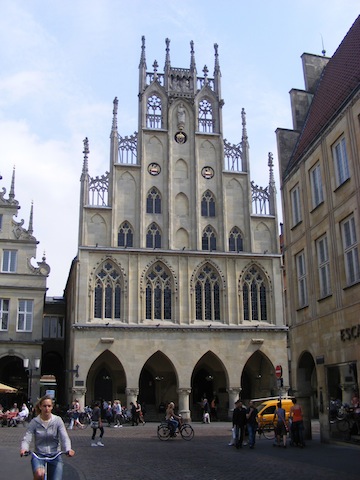
|
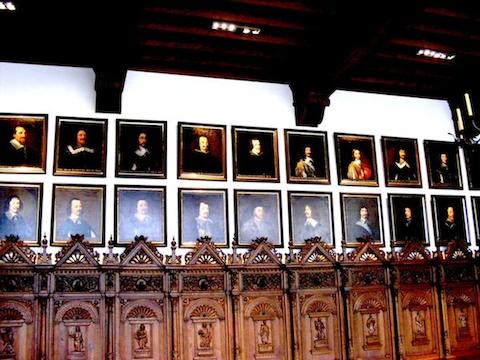
|
|
Street scene in Münster |
St. Paul's Cathedral Notice the bikes. |
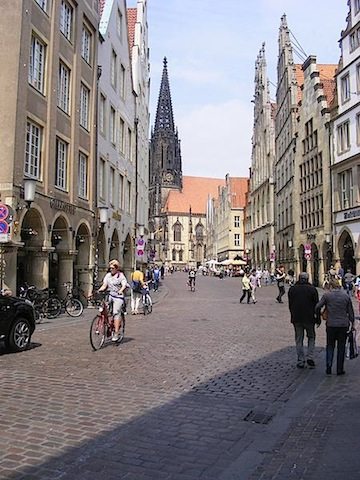
|
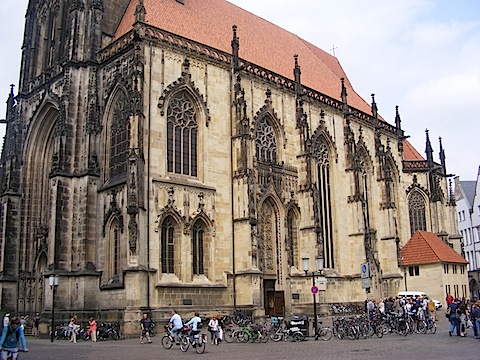
|
We saw new birds, new to us, nearly everywhere. Robins, falcons, swifts, wagtails, magpies, blackbirds and more. Al got pictures of some of them.
|
Bullfinch in Ingrid's garden |
Jackdaw on a lawn in Münster |
|---|---|
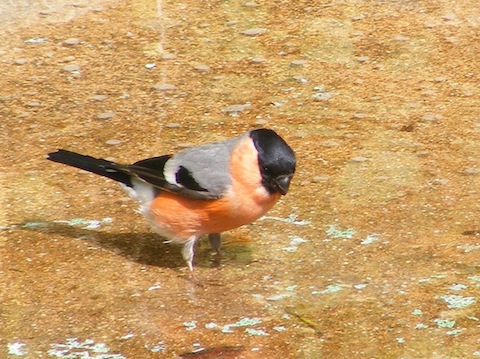
|
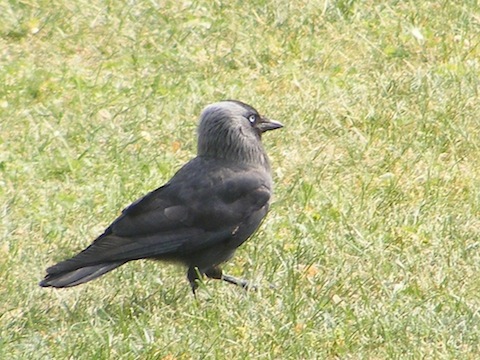
|
Everywhere we went, we were likely to see wind power farms. The German government is undertaking a major initiative to build transmission lines to take the electrical power from the north, where the wind blows, to the south, where power is needed. In addition, many houses (and barns) had solar power panels on their roofs.
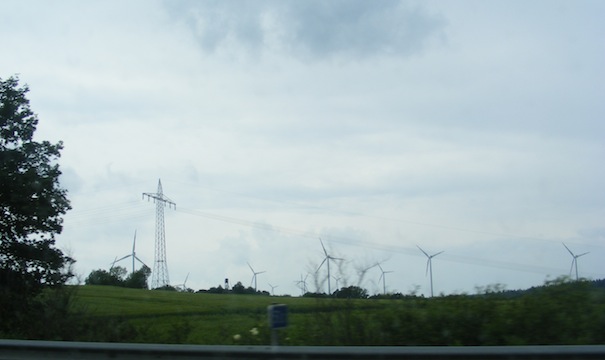
|
Our first overnight trip started with a car trip across the Rhine to the Mosel River valley, Germany's foremost wine producing region. We stopped first at the resort town of Bernkastel. It featured beautifully ornate old buildings and narrow twisting streets. Houses were built to jut over the street because they were taxed based on the ground area.
From Bernkastel, we went upstream to a wine tasting at the Weingut Martinshof winery in the village of Mehring. Our wine tasting was really a delicious meal accompanied by 8 or 9 bottles of wine (I lost count) with comments on the wine and stories by the owner.
We stayed that night in a very nice little hotel, the "Alt Mehring" Gäusthaus. Having drunk more than one bottle of wine each, it was good that the hotel was just across the street from the winery.
|
A street in Bernkastel, a resort town on the Mosel River |
In front of Bernkastel's Rathaus Gail, Klaus, Holger with Felix, Ingrid and Ilse |
|---|---|
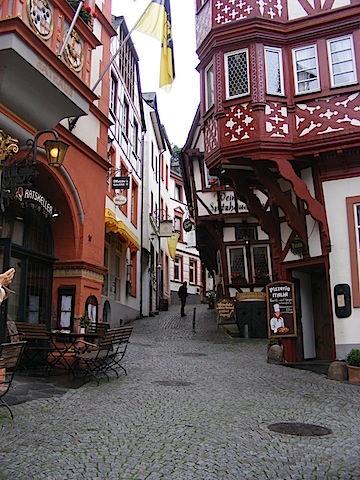
|
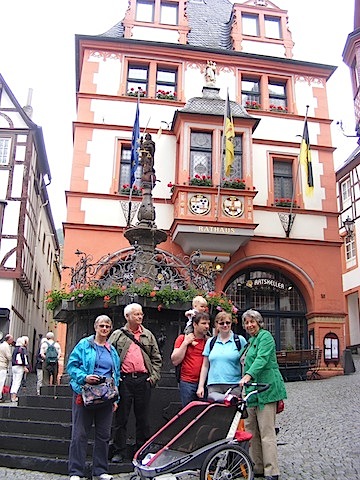
|
|
At the wine tasting Photo thanks to Ingrid |
|
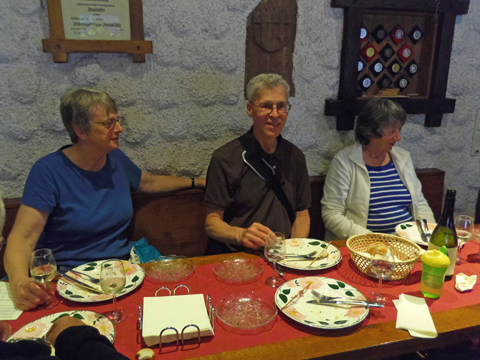
|
The morning after the wine tasting, we headed further up the Mosel to the ancient city of Trier. Founded in 17 B.C., Trier was important in the past, having became one of the capitals of the Roman empire in 286 C.E. We visited: the Porta Negra, the oldest surviving Roman gateway; the cathedral where they have a tunic brought from Jerusalem by the mother of the Roman emperor Constantine and thought to have belonged to Jesus; the Constantine Basilica, originally built as the throne room for the Roman emperor and now a Protestant church; the Ratskeller (the restaurant under the Rathaus) where we ate a noonday dinner; and an ice cream parlor.
Not all the city's history is ancient; Karl Marx was born here.
|
Porta Negra |
Fruit seller at the market in Trier Strawberries and asparagus were in season |
|---|---|
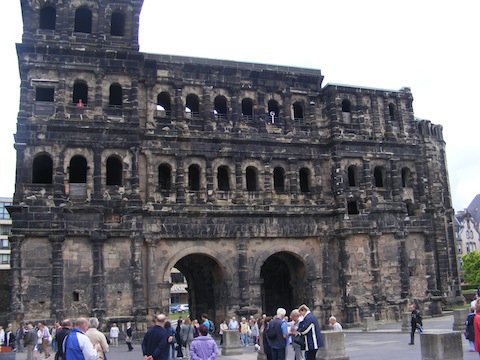
|
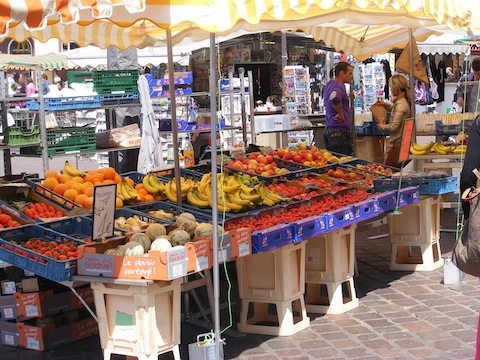
|
|
Constantine Basilica |
|---|
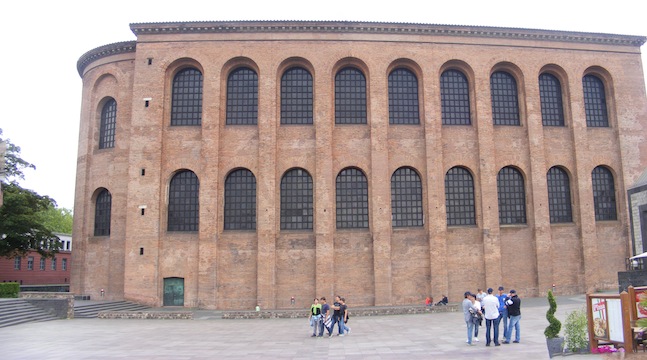
|
|
Gail at the entrance to the old Jewish ghetto |
House with its entrance door on the 2nd floor |
|---|---|
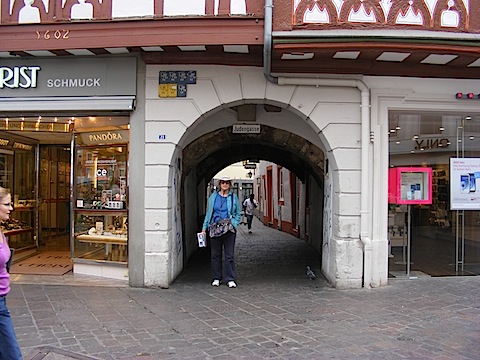
|
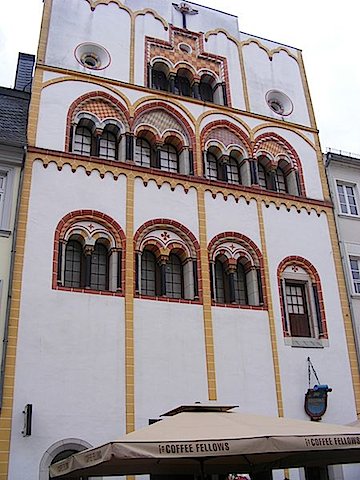
|
|
Lions supporting a balcony of the Palais Wallderdorff |
Closeup of the smiling lions |
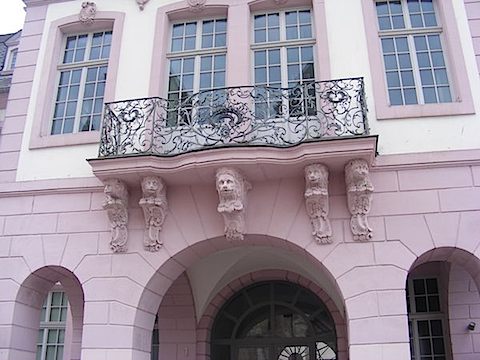
|
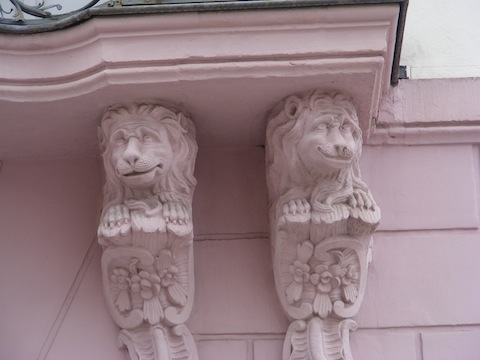
|
From Trier, we went to Aachen, the political center of Charlemagne's empire. On Saturday the plaza in front of the town hall was home to a noisy show of historic cars. We found our way past the cars and into the hall, which was originally Charlemagne's palace and where German kings and queens were crowned from 936 C.E. until 1531 C.E. We also visited Aachen cathedral, which is built around the octagonal Palace Chapel of Charlemagne.
|
Aachen Cathedral The eight-sided center was Charlemagne's Palace Chapel |
Some of the interior of Charlemagne's Palace Chapel |
|---|---|
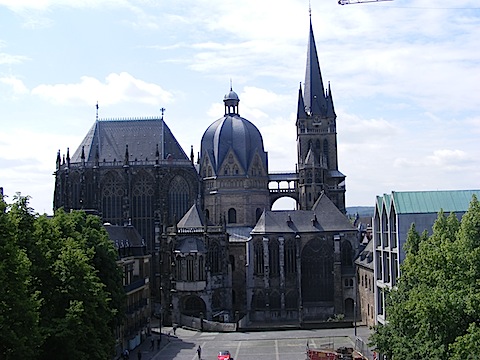
|
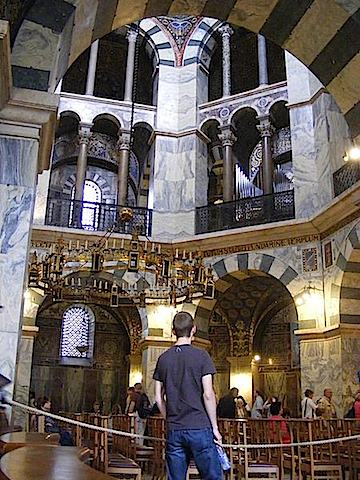
|
|
The Coronation Hall in Aachen's Town Hall |
A wall of the White Room in Aachen's Town Hall |
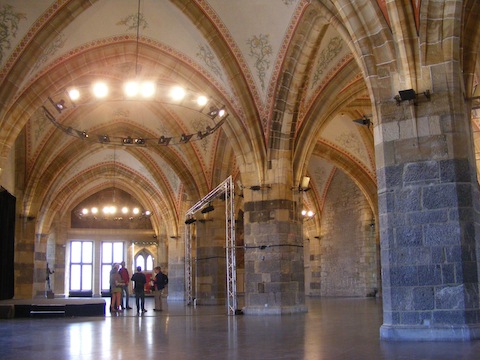
|
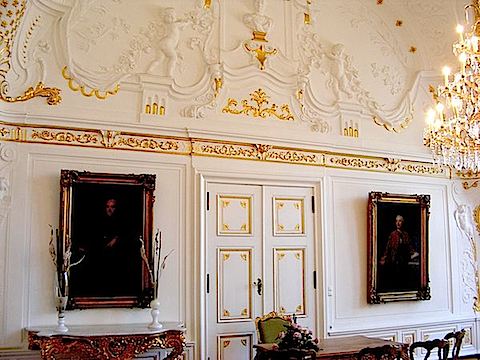
|
|
Al and Felix Photo thanks to Ingrid |
|
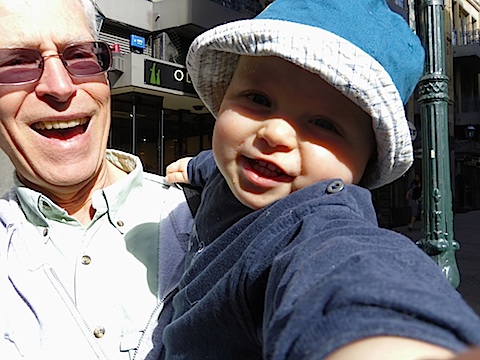
|
|
After all the sightseeing, we needed at day of rest back in Gelsenkirchen.
Furthermore, it had begun to
rain and turned colder, reaching a high of only 10ºC (50ºF).
In the afternoon we visited Schloss Lembeck, a small castle surrounded by a moat. Wearing felt slippers over our shoes in order not to damage the floors, we saw the elegant interior. You can rent it for a "destination wedding". The next day we headed east 230 kilometers to the Treetop Walk Edersee in a nature park near Bad Wildungen. The light rain stopped long enough for us to enjoy eating a picnic lunch, walking through the forest and climbing the ramp to a platform nearly 100 feet above the forest floor. Next we went to Hameln, the Pied-Piper city. There we found more beautiful 16th and 17th century buildings, many with modern shops installed in their ground floors. Gail's mother's grandparents had come from a village near Hameln to Illinois in 1848. One of the exciting aspects of our trip was to visit Bekede, Meinsen and Eimbeckhausen, the villages where the Busses and Henjeses had lived and worshipped, and St. Nicolai Kirche where they were members of the congregation. We found records of the birth and baptism of her great-grandfather and her great-great grandparents. We even learned that in Germany her great-grandfather's family name, Hennies, was spelled differently than in the U.S., Henjes. |
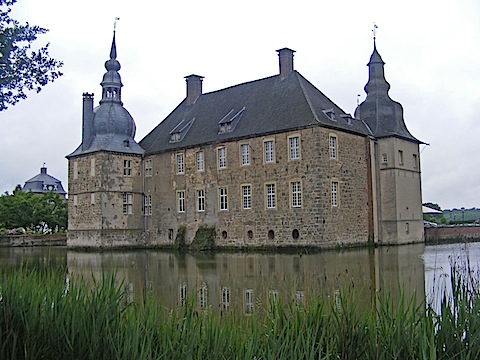
|
|
Holger, Gail and Ingrid at the peak of the Treetop Walk A row of camping trailers is visible on the opposite shore of Edersee |
Hameln Building from 1608 |
|---|---|
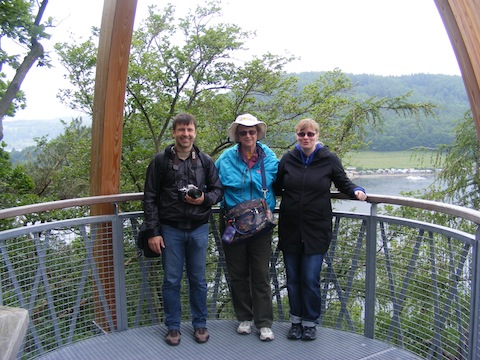
|
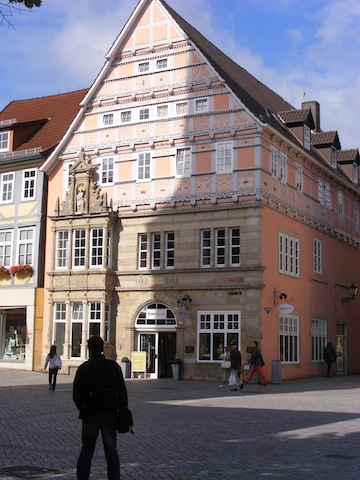
|
|
Building in Hameln dated 1589 and used as a museum |
Sculpture in Hameln commemorating the fall of the Iron Curtain |
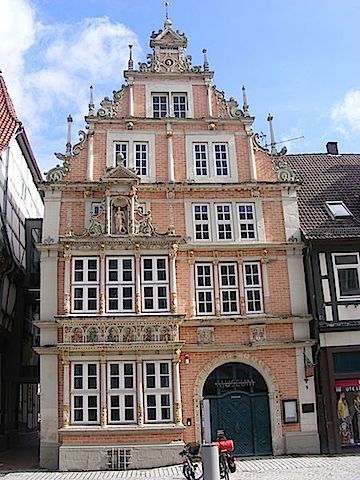
|
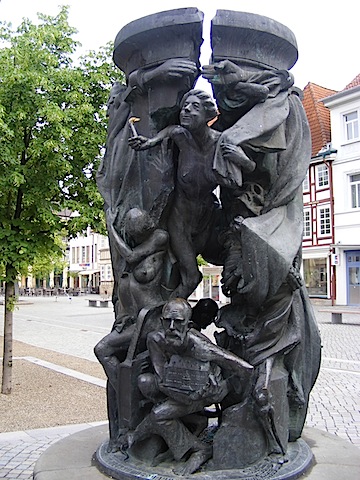
|
|
Old clock tower at St Nicolai church where the records of Gail's ancestors are kept |
Baptismal record of Johann Carl Christian Hennies Gail's great-grandfather |
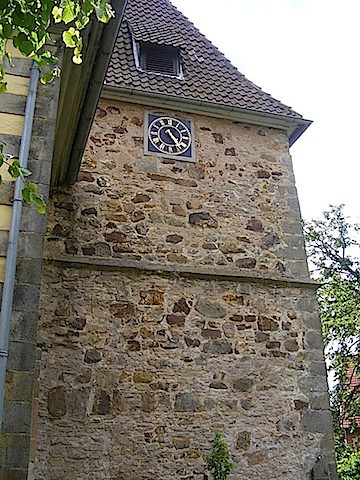
|
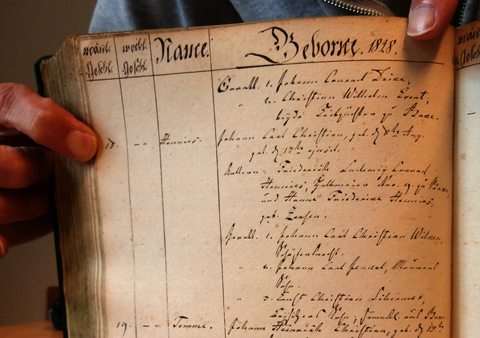
|
For our last full day in Germany, we returned to the mining theme and visited the Deutsches Bergbau Museum. It was very well done with a series of tunnels under the museum showing the evolution of mining practices during the past century. We even had an opportunity to run a pressurized-air hammer. Above ground also there were good exhibits of mining history, mining tools, and minerals and ores.
|
Cathedral-like doors to the mining museum in Bochum |
|---|
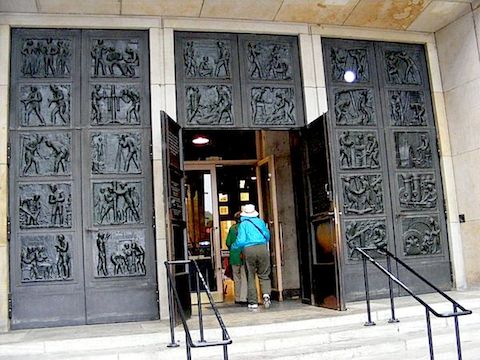
|
We flew back to Maryland on Thursday, June 7. We had had a wonderful time thanks to the generosity and cheerful nature of our hosts. They gave us a place to stay, fed us, acted as tour guides, translators and chauffeurs. We saw intriguing art, majestic buildings and natural beauty. We learned about spaghetti ice cream and quark, and even learned a few words of German. Surprisingly, despite great food and abundant ice cream shops, we did not gain any weight.
Let's do it again! When will we be back? Only the Universal Answer Machine can tell for sure.
